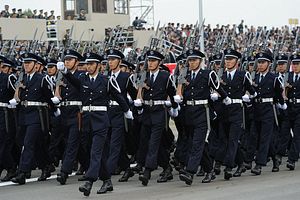This week, Admiral Harry J. Harris, Jr, U.S. Pacific Command (USPACOM) commander, made headlines for his testimony before the Senate Armed Services Committee. In the written testimony submitted to the Committee, he articulated his view that China sees the South China Sea as “a strategic front line in their quest to dominate East Asia out to the Second Island Chain.” During the hearing he went a step further and argued: “In my opinion, China is clearly militarizing the South China Sea… you would have to believe in a flat earth to believe otherwise.”
As China ramps up its activities in the South China Sea — which include the deployment of surface-to-air missiles, radar facilities, and most recently fighter jets — it continues to put pressure on Japan in the East China Sea, both in the aerial and maritime domains. Following the Japanese government’s decision to purchase three islands included in the Senkaku Islands in September 2012, Chinese official aircraft and ships have increased the frequency of their activities in the area. According to the figures released by the Japan Ministry of Defense (JMOD), its Air Self-Defense Force (JASDF) scrambled against Chinese aircraft 373 times between April 1, 2015 and December 31 2015 (by comparison, JASDF jets scrambled against Russian aircraft 183 times during the same period).
In the maritime domain, the Japan Coast Guard has also been facing increasingly active Chinese vessels operating in the East China Sea. Chinese vessels have entered what Japan considers to be its territorial waters around the Senkakus regularly since September 2012.
Japan has already moved to take steps to respond to the increasing pressure in the East China Sea in recent years. Its most recent National Defense Program Guidelines, released in December 2013, articulates that one of its priorities for the Self-Defense Force (JSDF) is the defense of remote islands. As such, the current Mid-Term Defense Program, covering the JSDF build-up plan between FY2014-FY2018, laid out a force posture that focuses on (1) development of amphibious operation capability, (2) enhancement of maritime domain awareness, and (3) augmentation of air defense capacity based in Okinawa.
The MTDP is up for revision in two years; JMOD will likely begin to lay the groundwork for it soon. As Japan proceeds to revise the MTDP, it needs to think hard on how to balance the need for modernization and the need for taking care of its people.
Given the nature of the challenges that Japan faces in this area, the force posture adjustment and the new acquisitions that the current MTDP has taken on are all appropriate investments. However, in order to make these investments truly effective, Japan also needs to begin investing more in the support systems that is are critical to enable JSDF operations. However, too often, the acquisition of front-line investments such as F-35As, Global Hawks, Amphibious Assault Vehicles, and V-22 Ospreys are prioritized with very little discussion on how much investment is required to ensure that the JSDF personnel are adequately trained to take advantage of the new systems, and the acquired systems can be maintained and repaired accordingly.
For instance, the decision to add another F-15 fighter squadron to Okinawa is an appropriate one, given the increasing operation tempo of the existing squadron. But “moving a squadron” is not just about moving the fighter jets. It also requires building more hangars for the aircraft, creating a larger space for education and training, and bringing in more JASDF pilots and support personnel to operate the additional F-15s (as well as their families). At least, it should, for the sake of the quality of life of these personnel.
The challenges involved in such trade-offs are not unique to Japan. At minimum, though, there need to be more discussion in Japan about these trade-offs. Given the reality that Japan continues to ask the JSDF to take on more responsibility, the discussion on how to better take care of its people is long overdue.
































